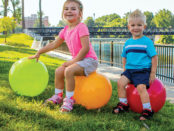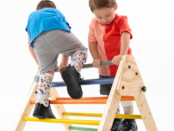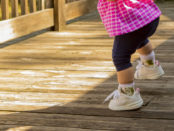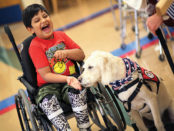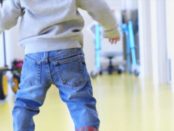SMO
Supramalleolar orthoses, SMOs, are commonly prescribed devices for young children who present with benign hypotonia and excessive pronation, or flexible pes planus – a generalized, ligamentous laxity in the foot.
Otto Bock WalkOn Reaction AFO by The O&P EDGE, September 2, 2025 A team of researchers conducted a literature review across six databases (PubMed, Web of Science, EBSCO, Scopus, Cochrane Library, and Sage) to evaluate the clinical
… READ MORESurestep Surestep’s dynamic SMOs (supramalleolar orthoses) use compression to stabilize the foot and ankle, allowing for the development of intrinsic muscles, muscle strategies, and movement patterns. Surestep is the most effective
… READ MOREKey takeaways: Pediatric patients with physical disabilities had limited mobility and higher pain scores vs. typically developing youth. Results showed happiness did not correlate with motor function. Surestep By Casey Tingle, Fact
… READ MORENew parents have plenty on their minds. Baby’s health. Baby’s needs. Baby’s future. Muscles are way, way down on the list. But if your little one is facing developmental delays, muscle concerns are near the top. At first
… READ MORESurestep birthday party. Physiopedia UK November 6, 2019 An orthosis by definition, is “an externally applied device used to modify the structural and functional characteristics of the neuromuscular and skeletal system.”
… READ MOREFrequent re-evaluation of orthotic devices is important because children quickly outgrow them and can undergo skin breakdown from improper use of this equipment. Summer camp for children with cerebral palsy. CerebralPalsy.org Author:
… READ MOREThe higher profile the device, the more it perturbs movement, and sometimes kids reject such orthoses because of discomfort or unwieldiness. Starting with the least restrictive device and responding to subtle changes in children’s
… READ MOREThe literature on preschool-aged and older children with Down syndrome tends to be consistent with conventional understanding of orthotic principles, but in very young children clinical decision-making about orthoses must also
… READ MORESummary. The good news is that AFOs appear to provide clinical benefits in the management of CP. The bad news is that these benefits are modest relative to the gait deficits experienced by this population, and global indices of gait
… READ MOREInvestigators found 79% of children who had ever been toe-walkers spontaneously developed typical gait by 10 years of age and did so without intervention or contractures of the ankle dorsiflexion. There are a number of reasons some
… READ MOREHalf of those diagnosed with cerebral palsy have been prescribed standard AFOs to aid in walking, according to United Cerebral Palsy and the CDC. A patient with CP at Shriners Hospital for Children—Chicago wearing his customized
… READ MOREWhen toddlers are learning to walk, many spend some time walking up on their tip toes, which is known as toe walking. Commonly this is to get into things they aren’t meant to, but as they perfect their walking, they walk more with
… READ MOREThe use of a carbon fiber ankle-foot orthosis with supramalleolar orthosis inner boots improved the gait of a 13-year-old patient with spastic diplegic cerebral palsy, according to data presented at the Association of Children’s
… READ MOREPediatric toe walking is not necessarily idiopathic and can be the result of an underlying deficit, Megan Smith, CO, director of clinical research at Surestep, said at the Association of Children’s Prosthetic-Orthotic Clinics Annual
… READ MOREWalking barefoot on a gravel surface significantly improved gait in children with idiopathic toe walking, according to research presented here at the American Orthotic & Prosthetic Association National Assembly. Researcher Mark
… READ MOREThey are not just small adults; some things are very different, though some are just smaller. I often tell our physical medicine and rehabilitation residents in training that there are only two differences between adult and pediatric
… READ MOREModern orthotic devices are designed to fit more intimately than in the past, a development that allows for more effective biomechanical correction. But this evolution has also led to an increase in the incidence of lower extremity
… READ MOREEarly care advised for FAI prevention. “…ankle sprains in children with CMT are not prevented adequately as the neurological condition is not often diagnosed in childhood, unless present in another family member. He noted that
… READ MOREBalance improves over time in children with cerebral palsy, CP, who switch from a dorsiflexion-free orthotic device to a more restrictive one, according to research from Northwestern University’s Feinberg School of Medicine in
… READ MORENo rubbing on toes with SmartKnit XStatic-Toe. Accessorize your SMOs, AFOs, KAFOs with SmarKnit Seamless Socks SmartKnit socks are made especially for kids and adults wearing AFOs. Feet and legs stay comfortably cool with wicking
… READ MOREAdjustable dynamic response (ADR) AFOs addressed common gait abnormalities in an adolescent with diplegic cerebral palsy, according to a presenter at the American Academy of Orthotists and Prosthetists Annual Meeting and Scientific
… READ MOREIf you ask Brennan Ryan what his favorite after-school activities are, he’ll tell you, “Basketball, baseball, flag football, and Cub scouts.” Ask him what his favorite part of school is and he’ll answer, “Recess.” This
… READ MORENew research underscores years of positive clinical results. When it comes to orthotic management of pediatric patients with hypotonia, the medical literature is only beginning to document the effectiveness that clinicians have been
… READ MOREQuantifying the effects of hypotonia starts in the clinic. Effective management of children with hypotonia requires an understanding of how the condition affects gait. Clinicians typically rely on their professional experience when
… READ MORE

